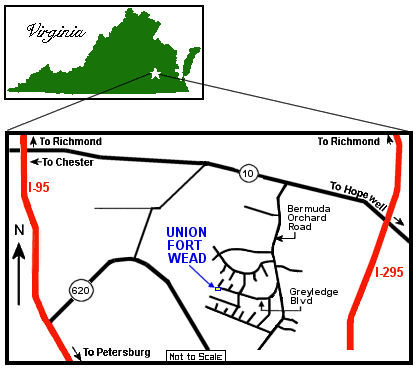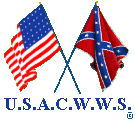
|
U. S. CIVIL WAR
PHOTOGRAPHS
|

|
FORT WEAD (UNION)


Fort Wead is located south of Richmond, Virginia, off of Route 10, between
Chester and Hopewell. It's street address is 1107 Greyledge Boulevard.
In the text, the icon  is a link to the definition of the word it marks.
is a link to the definition of the word it marks.
Use your browser's "back" button to return to this page.
| |
Fort Wead was constructed in June 1864 at the rear of
the Union lines. Although it's purpose was to prevent Confederate forces from
advancing in the event the Union lines were broken, it was never used.
In this section, photographs of the Chesterfield County interpretive signs
at Fort Wead, along with photographs of their locations, and the text of the
signs are presented.
|
|

This photograph was taken toward the East from one of the
Artillery positions on the West wall . The letters and arrows mark:
A = Entrance
B = Powder Magazine
C = Sally Port
|
|

|
FORT CONSTRUCTION: Most Civil War earthen forts were built by standard
military manuals. First the outside limits of the fort were laid out. Then the
moat would be started. As the dirt was placed inside the moat limits to
construct the walls, interior supports would be placed on the inside to hold
the dirt. When complete, the fort would have infantry firing steps, artillery
platforms, embrasures , and
a powder magazine. , and
a powder magazine.
|

Outside earthen wall above the now-dry moat.
|
|

|

|
POWDER MAGAZINE: This magazine was built to hold gun powder and shells
for the guns. Magazines were built in rear of the parapet of the battery. An
excavation of four to five foot is dug and a roof is placed at same level as
the ground. The roof may be strengthened by layers of timber. The top is
covered by earth to a dept of seven feet. The entrance for the covered passage
is turned from the enemy, so to be protected from incoming fire. of the battery. An
excavation of four to five foot is dug and a roof is placed at same level as
the ground. The roof may be strengthened by layers of timber. The top is
covered by earth to a dept of seven feet. The entrance for the covered passage
is turned from the enemy, so to be protected from incoming fire.
|
|

|

|
ARTILLERY POSITIONS: The west wall has positions for six pieces of
artillery. The guns that were placed here were known as 32 pounders. In this
fort they were to be used as giant shot guns, sweeping the open field to the
west with canister . Canister is a
tin can loaded with iron balls about the
size of golf balls. These would cover the ground in a wide pattern and were
deadly to infantry. On June 2, 1864, the Federal line to the west was in
danger of falling, so the guns in the fort would cover the rear of the line if
it was overrun. The platforms for the guns and the embrasures are still visible
today. One is in each corner and a platform for four guns is in the center. . Canister is a
tin can loaded with iron balls about the
size of golf balls. These would cover the ground in a wide pattern and were
deadly to infantry. On June 2, 1864, the Federal line to the west was in
danger of falling, so the guns in the fort would cover the rear of the line if
it was overrun. The platforms for the guns and the embrasures are still visible
today. One is in each corner and a platform for four guns is in the center.
|
 >
Civil War Photos
>
Richmond - Outlying Area
>
Fort Wead
>
Civil War Photos
>
Richmond - Outlying Area
>
Fort Wead




